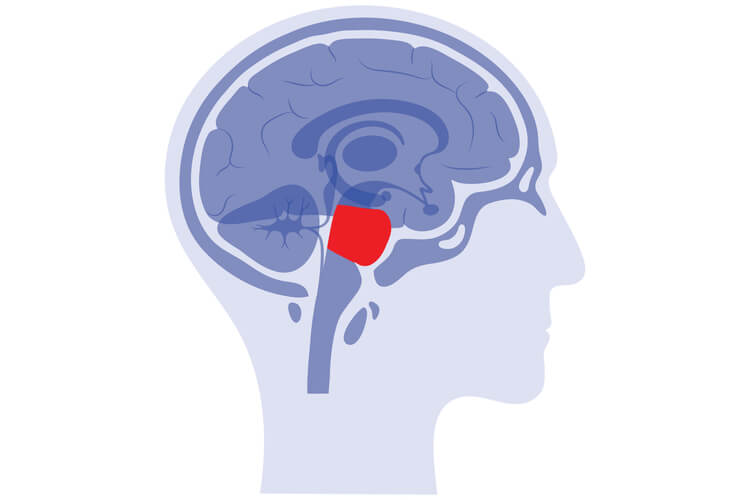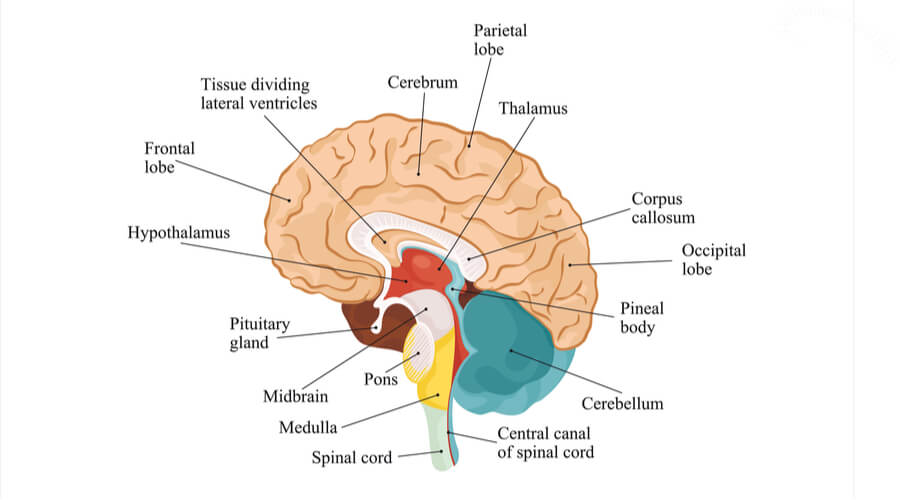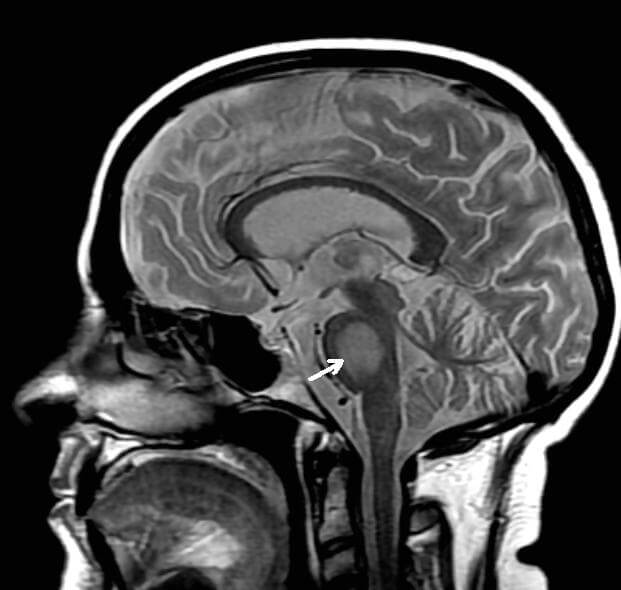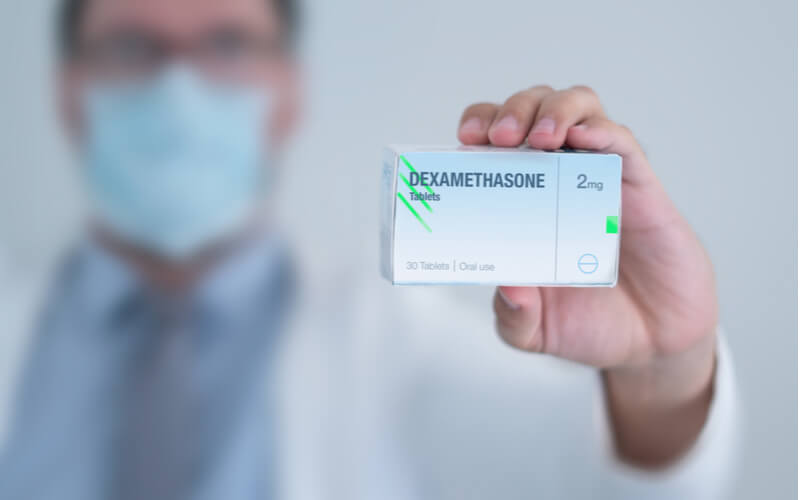Definition
The pons is a part of the brain stem which connects the medulla oblongata and the cerebral cortex.
The pons can also be called the pons Varolii, and the word ‘pons’ is Latin for ‘bridge’ – which is an appropriate name for its function!

Pons Location
The pons is the largest part of the brain stem, sitting superior to the medulla oblongata and inferior to the midbrain, connecting the two.
It is also anterior to the brain’s cerebellum and posterior to the pituitary gland.
Pons Structure
The pons is approximately 27mm long and is made up of two areas: the ventral pons and the dorsal pons
Ventral
The ventral part of the pons contains pontine nuclei, as well as corticopontine and corticospinal tracts traveling vertically along this portion. It also has fibers crossing transversely from the pontine nuclei to the opposite cerebellum.
A groove called the basilar sulcus runs down the middle of the ventral portion, which accommodates the basilar artery.
Dorsal
The dorsal portion (AKA tegmentum) mainly contains the not-well-defined reticular formation which runs throughout the brain stem.
Pons Function
As the pons is, essentially, a large collection of different nerves and nuclei, it does not carry out one defined function – instead, it is involved in several different functions to do with both the central and peripheral nervous system.
For instance, several nerves originate from the pons, including nerves that control functions of the face such as the:
- Trigeminal nerve – controls facial sensation and chewing
- Abducens nerve – controls eye movement
- Facial nerve – controls facial expressions and movement
- Vestibulocochlear nerve – controls hearing and equilibrium maintenance
The pons also plays a role in:
- Regulating breathing rate (by assisting medulla oblongata)
- The control of sleep cycles
- The regulation of deep sleep
- Inhibition of movement during sleep (by activating inhibitory centers in the medulla)
The pons also helps to connect some parts of the brain. This aids in relaying sensory information from one place to another.
Parts of the brain that are connected by this area include:
- The forebrain and hindbrain
- The cerebrum and cerebellum

Central Pontine Myelinolysis
One disease that can affect the pons is central pontine myelinolysis.
Central pontine myelinolysis is a neurological disorder that results from the myelin sheath covering the pontine nerve cells being destroyed.
Central Pontine Myelinolysis Causes
This disorder does not often occur spontaneously.
One of the most common causes of central pontine myelinolysis is a sharp increase in blood sodium levels, which then leads to a rapid shift of water in the brain cells.
This is because sodium helps to regulate fluid levels in the cells, and so a sharp change in sodium levels will, therefore, lead to a sharp change in the fluid equilibrium.
Those being treated for hyponatremia (low blood sodium levels) are most at risk for developing central pontine myelinolysis, as the treatment for low sodium levels (i.e. intravenous infusion of sodium solution) can cause your sodium levels to increase too dramatically.
However, we are not yet entirely sure how this shift causes central pontine myelinolysis.
Central Pontine Myelinolysis Symptoms
Some symptoms of myelinolysis include:
- Weakness of the muscles in the face, arms, and legs
- Seizures
- Headache
- Confusion
- Difficulty swallowing
- Poor balance
- Slowed and/or slurred speech
- Delayed responses and reflexes
- Nausea and vomiting

Central Pontine Myelinolysis Complications
If left to progress for too long, central pontine myelinolysis can cause a number of different complications.
These mostly include neurological complications, but this disorder can also affect other parts of the body.
Some of these complications include:
- Ventilator dependence
- Locked-in syndrome (a state of being conscious with quadriplegia and paralysis of lower cranial nerves)
- Muscle atrophy
- Venous thromboembolism – a blood clot that forms in a vein
- Aspiration pneumonia
Central Pontine Myelinolysis Treatment
Though central pontine myelinolysis cannot be fully cured, there are some treatments that can help to ease the damage and symptoms.
Prevention
Naturally, one of the most effective treatments is prevention.
Central pontine myelinolysis can be prevented by monitoring and regulating the rate of sodium level correction, especially when treating hyponatremia.
Some studies have also found that desmopressin (a drug used to control excessive thirst and urination) can help reverse the overcorrection of hyponatremia. This can also help to prevent central pontine myelinolysis.
Support
Support will often be offered to help ease the symptoms of central pontine myelinolysis.
Measures to support those suffering from this disorder can include ventilator support, anti-parkinsonism drugs (e.g. levodopa), and physiotherapy and rehabilitation
Pontine Glioma
A pontine glioma is a cancerous (malignant) tumor that originates from the pons, developing from cells known as astrocytes (glial cells in the central nervous system).

Pontine Glioma Symptoms
A pontine glioma can be recognized from a number of different symptoms, including:
- Facial weakness
- Slurred speech
- Problems with swallowing
- Trouble maintaining balance
- Abnormal eye movements
Pontine Glioma Causes
No exact cause of pontine glioma has been found.
However, pontine gliomas normally develop in children and are rarely found in adults. In fact, they make up around 10-20% of all childhood brain tumors.
Pontine Glioma Complications
Unfortunately, however, only 10% of children survive for 2 years following their diagnosis, and less than 1% survive 5 years afterward.
Pontine glioma also comes with several complications during this time, including:
- Facial paralysis
- Hydrocephalus – accumulation of cerebrospinal fluid within the brain
- Brain herniation – pressing of the brain against skull structures
- Coma
Pontine Glioma Treatment
Pontine glioma is very difficult to cure, with tumors often growing again after several months.
Traditional cancer treatments such as surgery to remove the tumor or chemotherapy are not effective with pontine glioma.
However, there are several other treatment routes that patients suffering from pontine gliomas can take which may provide some relief.
Medication
Upon diagnosis, one of the first treatments offered will be steroids, most commonly a steroid known as dexamethasone.
These are often used to:
- Improve neurological symptoms
- Reduce the edema surrounding the tumor
- Prevent/minimize the edema formed by radiation therapy

Radiotherapy
Radiotherapy is a type of therapy that uses high-energy X-rays to damage the DNA of the cancer cells.
It is often used to try and eliminate these cells, and it improves symptoms in 80% of children. It can be used to prolong their survival by another 2-3 months.
